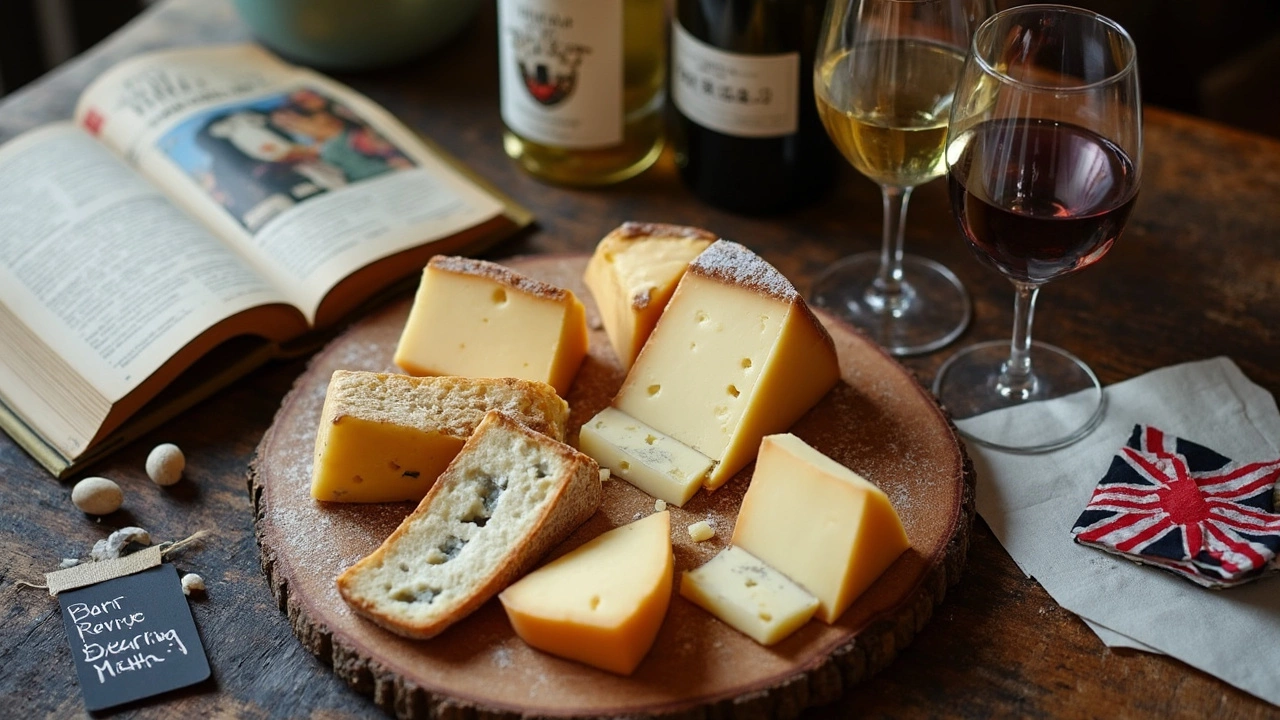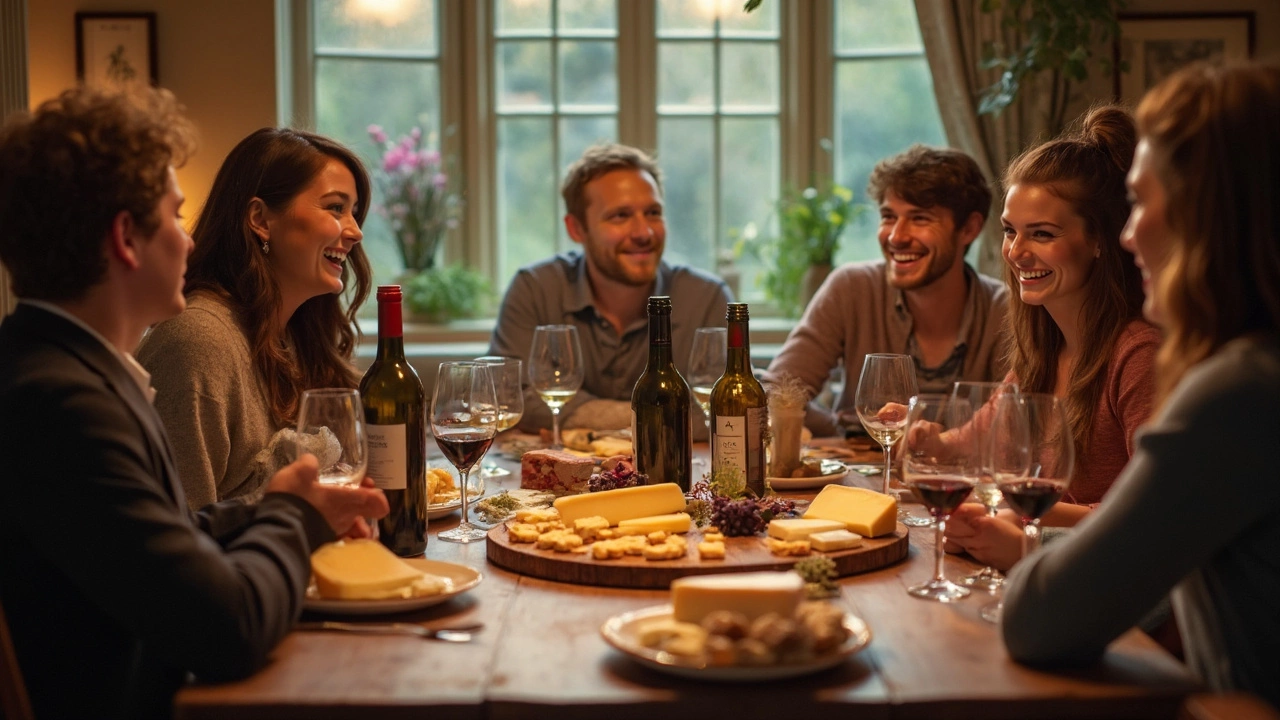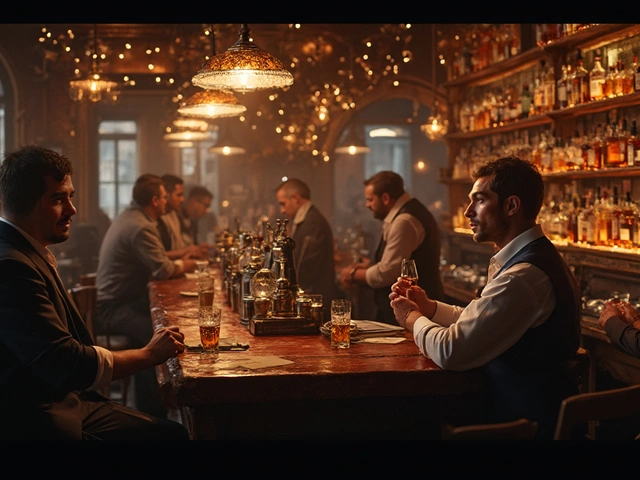If you think red wine is a no-brainer for cheese, you’re definitely not alone. Tons of folks just reach for a bottle of cabernet and hope for the best. But here’s the wild part—white wine often outshines red when it comes to cheese pairings. It sounds backwards, right? But try a tangy goat cheese with crisp sauvignon blanc. Suddenly, all those flavors just click together way better than with most reds.
The real deal is, not every cheese wants to hang out with the same kind of wine. A gooey camembert isn’t going to vibe the same way as an aged cheddar. Skip the rulebook for a sec and think about the texture and boldness of both your cheese and your wine. Lighter cheeses like a fresh mozzarella actually get totally overwhelmed by big-tannin reds, turning those bites kind of chalky and harsh. The same whites that work with seafood (think pinot grigio or riesling) are usually awesome with softer, creamy cheeses. It’s less about tradition, more about what tastes good together.
- Why White Often Beats Red (and When It Doesn’t)
- Matching Cheese Styles to Wine
- Common Pairing Pitfalls and How to Avoid Them
- Cheat Sheet: Fuss-Free Pairings for Every Occasion
Why White Often Beats Red (and When It Doesn’t)
Everyone’s heard that “red wine goes with cheese,” but if you’ve ever sipped a big cab with brie, you probably noticed something got lost. Here’s the scoop: white wine wins out more often than not with most cheeses, especially soft and mild ones. The acid in whites, plus the chill, helps cut through creaminess and balance flavor.
Richard Betts, a Master Sommelier, puts it this way:
“White wine and cheese are best friends. The freshness and fruitiness of whites let the cheese shine. With red, tannins often clash with the fat, making both taste dull.”
The science backs this up. Tannins in red wine can make creamy cheeses taste chalky, and the cheese can make the wine come off as sour or flat. Dry whites like sauvignon blanc, riesling, or even sparkling wines, work wonders because their acidity slices through fat and highlights the cheese’s flavors. Here’s a quick breakdown of how different wines interact with cheese:
| Wine Type | Cheese Type | Result |
|---|---|---|
| Sauvignon Blanc | Goat Cheese | Bright, tangy, flavors pop |
| Chardonnay (unoaked) | Brie, Camembert | Silky, creamy balance |
| Cabernet Sauvignon | Brie, Mozzarella | Harsh, dries out palate |
But there’s exceptions. A bold aged cheddar, or firm cheeses like gouda, actually do better with red wine—especially if the wine’s not too heavy on tannins. Lighter reds (think pinot noir or grenache) can be great with nutty cheeses or milder blues.
- Go white for soft, creamy, or tangy cheeses
- Try lighter reds with aged or hard cheeses
- Skip big, grippy reds unless your cheese is sharp and robust
The old rules are more about habit than science. If you want your wine and cheese time to actually taste right, go by style and texture, not just color.
Matching Cheese Styles to Wine
Pairing wine and cheese isn’t about showing off your wine knowledge. It’s about making the flavors make sense together. So, let’s make it simple: match the strength and texture of the cheese with the mood of your wine. Here’s how it breaks down in real life.
- Soft, tangy cheeses like goat or feta: Stick with crisp whites. Sauvignon blanc, pinot grigio, or even a dry riesling totally nail it. These wines cut through the tang and keep things fresh instead of sour. Try it once—you’ll see what I mean.
- Brie, camembert, triple-cream: Rich cheeses love the acidity in sparkling wine and unoaked chardonnay. The bubbles or crispness slice through all that cream, so it doesn’t turn into a heavy, one-note bite.
- Cheddar, gouda, hard aged cheeses: Now your red wine gets a shot. Medium reds like merlot or pinot noir work better than monsters like cabernet. Too much tannin and the cheese can taste dry and weird. A sherry or even a hoppy beer also works, but that’s another story.
- Blue cheeses: Blue needs a little sweetness. Port wine, dessert riesling, or a sweet sherry are classic for a reason. The sugar balances all that sharp, salty funk. Serve with a grape or honey if you really want to impress.
If you want the nerdier details, check out the table below. It’s not fancy, just quick and handy when you’re staring at the grocery store shelves.
| Cheese | Best Wine Pairing |
|---|---|
| Fresh Goat Cheese | Sauvignon Blanc |
| Brie | Champagne/Prosecco |
| Aged Cheddar | Merlot |
| Parmesan | Chianti |
| Blue Cheese | Port |
| Swiss | Pinot Noir |
Pairings aren’t about perfection; they’re about balance. You want both your wine and your cheese to taste better with each other, not like they’re fighting for attention. Start simple. You’ll pick up the pattern way faster than memorizing a bunch of fancy rules about wine and cheese pairings.

Common Pairing Pitfalls and How to Avoid Them
Messing up wine and cheese pairings usually boils down to one of two things: picking a wine that’s way too bold for the cheese or choosing flavors that just crash into each other. Here’s what trips people up the most, and how to dodge those mistakes the next time you’re reaching for that bottle.
1. Overpowering the Cheese
- Going with a heavy red wine (like cabernet or malbec) alongside mild cheeses almost always backfires. The tannins can make creamy cheese feel gritty and bitter in your mouth. Reds aren’t off limits, but stick to lighter reds (think pinot noir) with softer cheeses.
2. Ignoring Acidity
- Acidic white wine (like sauvignon blanc) can lift a tangy goat cheese and actually freshen your palate. Rich, oaky whites (like chardonnay) with very salty cheeses, on the other hand, can leave your taste buds feeling wiped out quickly.
3. Pairing Funky with Sweet
- If you go for a funky blue cheese, sometimes the only wines that work are sweet: think port or even a dessert riesling. A dry red next to blue? You’ll wonder why you even bought the cheese. The salt and funk need that sugar hit to balance things out.
4. Forgetting About Texture
- Hard cheeses (like parmesan or aged gouda) usually play nice with both reds and whites, but always look for a wine with a bit of body to stand up to the cheese’s crumbly texture. Soft cheeses and bubbles? Total win. Dry sparkling wine slices right through the richness.
Here’s a quick cheat sheet to sidestep those classic pairing fails:
| Cheese Type | Safe Wine Bet | Pitfall to Avoid |
|---|---|---|
| Soft & Creamy (Brie, Camembert) | Chardonnay, Dry Rosé | Big red wines (tannic, overpowering) |
| Hard & Aged (Cheddar, Gruyère) | Pinot Noir, Merlot, Oaked White | Super acidic whites (might clash) |
| Pungent Blues (Gorgonzola, Roquefort) | Sweet Whites, Port | Dry reds (taste sharp, metallic) |
| Fresh Cheeses (Goat, Feta) | Sauvignon Blanc, Champagne | Oaky or heavy wines (lose freshness) |
If you’re ever stuck, go for bubbles or a crisp white wine with most cheeses—honestly, those two rarely go wrong. And if you’re mixing and matching a lot of cheeses, grab a few bottles that swing both ways. Your cheese board (and your friends) will thank you.
Cheat Sheet: Fuss-Free Pairings for Every Occasion
If you want to skip the guessing game, this section’s for you. When you build a cheese board or bring a bottle to your friend’s, sticking to these simple wine and cheese pairings can save you from some flavor disasters. The goal is to match up styles so no one flavor steals the show.
- Soft goat cheese goes best with Sauvignon Blanc or Pinot Grigio. These whites are zesty and lift up tangy, creamy cheese instead of drowning it out.
- Brie and Camembert love Champagne or dry Prosecco. Bubbly cuts through the richness and keeps your mouth refreshed bite after bite.
- Aged Cheddar works with bold reds like Cabernet Sauvignon or Zinfandel—the kind with a bit of bite that can hang with salty, sharp cheese.
- Blue cheese? Port or Sauternes is classic, but if you want to stick to table wine, try an off-dry Riesling for a sweet-and-funky combo.
- Parmesan or Grana Padano loves Chianti or Sangiovese. The saltiness mellows the wine’s acidity.
You don’t need to memorize all this—just remember, red wine pairs best with harder, saltier cheeses and white wine tends to ace it with soft and creamy styles.
Check this quick chart next time you’re in the aisle, and you’ll look like you know exactly what you’re doing:
| Cheese Type | Best Wine Pairing |
|---|---|
| Goat (chèvre) | Sauvignon Blanc |
| Brie/Camembert | Champagne |
| Aged Cheddar | Cabernet Sauvignon |
| Blue Cheese | Port/Riesling |
| Manchego | Tempranillo |
| Swiss (Emmental, Gruyère) | Pinot Noir |
Last tip—if you’ve got a mixed cheese platter and just want one bottle, go for a dry sparkling wine like Cava or Champagne. Bubbles go with almost everything, and they won’t clash with the flavors or leave your mouth feeling heavy.


